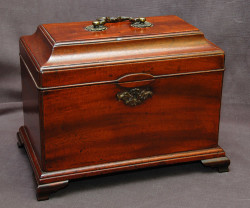Tea, Status and Storage Part One 17th to Mid 18th Century
Tea, Status and Storage Part One 17th to Mid 18th Century
By Hannah Crouthamel
Brief History of Tea in England
Tea, originally used in China in the 4th century as a healing beverage, found its way to Europe in the 16th century, and to England by the early 17th century. In 1639 the “Garraways” opened by Sir Henry Garraway, governor of the East India Company, was  the first coffee house to serve tea. By 1664 the English East India Company was importing tea and hailing its efficacy for curing “colds and defluxations”. By the early 18th century tea was being sold in liquid as well as leaf form in coffee houses, apothecaries, as well as in shops that catered to the female market.
the first coffee house to serve tea. By 1664 the English East India Company was importing tea and hailing its efficacy for curing “colds and defluxations”. By the early 18th century tea was being sold in liquid as well as leaf form in coffee houses, apothecaries, as well as in shops that catered to the female market.
Tea was very expensive. In 1665 it sold for 16 to 50 shillings a pound, that at a time when the average skilled workman earned less than 20 shillings a week. Tea was touted as a delicious beverage with therapeutic properties. It was taxed heavily and as a result came to be smuggled extensively. In 1700 only 70 pounds of tea was imported to England; by 1730 that had risen to about a million pounds. The lure of tea was extreme and by the 1730’s poor working people were partaking of the beverage, though it had been “recycled”. Servants often dried the tea leaves after they had been used and then sold them in the underground economy as did workers in tea shops. This resulted in even wider dissemination of the brew. By the middle of the 18th century, recycled tea had found its way into most corners of society, and tea could be bought by the “pinch” which made it more accessible to all classes and wove this beverage into the very fabric of English life. (more…)
